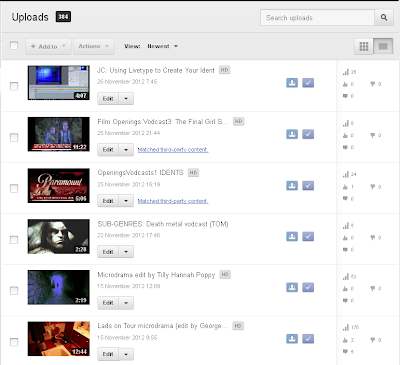Your final AS coursework production must not feature any copyrighted material, but some of your vodcasts might. Below I consider some of the issues and considerations involved.
Since YouTube introduced an automatic detection system (see
the Wiki) and signed deals with most of the major TV, film and music companies (as you'll have seen from your Media work, these tend to be subsidiaries of massive horizontally and vertically integrated conglomerates such as News Corp and NBC-Universal), the issue of 'fair usage' of copyrighted materials has evolved a little.
 |
| Link at the end of the post: a very useful site for exploring the issue further |
If any of your work contains any copyrighted material you might find its deleted by YouTube, or blocked in certain nations but not others (dependent on which countries its deals have been signed in). This will particularly the case where you've used lengthy clips from films. Where you've used a short clip, or any copyrighted music, you're more likely to find a notice on your channel uploads page telling you there is 'matched copyright material'.
 |
| My vodcasts used clips short enough to be considered 'fair usage' |
Rather than delete or block the upload, the more common response is simply to assert that other copyright holders' material has been used, and force ads onto your upload, the revenues from which will be split between YouTube and the copyright holder.
I've tried to find a definitive acceptable length of film clips which won't generate a YouTube blocked upload, without success so far (if you find anything on this please pass it on). I'd suggest aiming for 30secs or less, using freeze frames with original audio removed for anything over this, but that's a guess. Check your uploads for anything being blocked. So far, we've not problems with any A2 music videos, just AS film vodcasts (and a compilation of scenes which used a Depeche Mode a couple of years ago), including one of mine (vodcast on scream queens + final girls, available to view on request) in which I simply used too much of
Bride of Chucky.
FairUseTube.org provide a very considered analysis of the issues involved, YouTube's policies and also highlight some of the common abuses - where fraudulent companies simply claim you've used their copyright material when that's not the case. I think I may have found one such dubious claim on my channel, for past AS coursework where the soundtrack was composed in school using GarageBand! In such cases, the fraudulent company pockets the money from ads which YouTube force on to the upload.
See
http://fairusetube.org/dvd-ripping-guide;
http://fairusetube.org/youtube-copyfraud;
http://fairusetube.org/guide-to-youtube-removals and other such links on the site.
YouTube itself offers a guide, including lengthy videos, though they shy away from being specific over such matters as how much of a single TV show, film or other text goes beyond the fair usage doctrine - see also
the Wiki on Fair Usage.
The Uni of Houston's DigitalStoryTelling site also features a considered discussion of the issues and legal policies.

